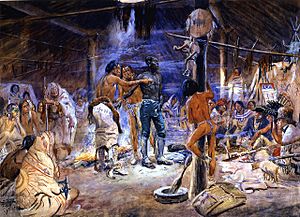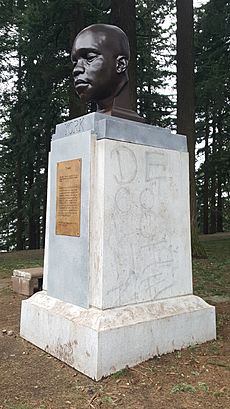York (explorer) facts for kids
Quick facts for kids
York
|
|
|---|---|
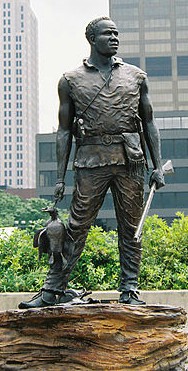
York statue at Riverfront Plaza/Belvedere, Louisville, Kentucky
|
|
| Born | 1770–75 |
| Died | After 1815 |
| Occupation | Body servant (enslaved), explorer |
| Employer | Enslaved by William Clark |
| Known for | Participating in the Lewis and Clark Expedition |
| Spouse(s) | 1 |
| Parent(s) | Old York, Rose |
| Relatives | Juba (brother), Nancy (sister), Scipio (half-brother), Daphney (half-sister) |
| Military career | |
| Service/ |
|
| Years of service | 1803–1806 |
| Rank | Sergeant (honorary posthumous – Presidential citation) |
York (born between 1770 and 1775, died after 1815) was an American explorer. He was the only African-American member of the famous Lewis and Clark Expedition. York took part in the entire journey and helped make it a success. He was the first African American to travel across the continent and see the Pacific Ocean. Today, York is seen as an important American figure, and several monuments honor his legacy.
York was born into slavery. His parents, Old York and Rose, were enslaved by John Clark III, who was William Clark's father. William Clark inherited York in 1799. York was a strong and large man, weighing around 200 pounds. He was about the same age as William Clark. People described his skin as very dark and his hair as short and curly. Like most enslaved people, York could not read or write. Because of this, we do not have much information directly from him.
After the expedition, York hoped to be given his freedom because of his "immense services." However, William Clark refused many times. Clark became upset when York did not want to return to his old life as a servant. Clark was also annoyed that York wanted to stay in Louisville, where his wife lived. Clark eventually sold York.
For many years, not much was known about York's life after the expedition. About 20 years later, Clark told writer Washington Irving that he had freed York. Clark said he helped York start a business moving goods between Nashville and Richmond. However, Clark claimed York was lazy and died of a disease called cholera.
Many historians today believe Clark's story was not true. They think he might have said this to make himself look better. A fur trader named Zenas Leonard wrote a book about his travels. He described meeting a "negro man" living among the Crow Indians in what is now Wyoming. This man said he had first come to the area with Lewis and Clark. He was living well with the Crow people and was treated like a chief, with four wives. Many historians believe this man was York.
Contents
York's Early Life
York was born in Caroline County, near Ladysmith, Virginia. He and several family members were enslaved by the Clark family. William Clark's father, John Clark III, mentioned York and his family in his will. This document shows that York, his parents Old York and Rose, and his siblings Nancy and Juba were enslaved by the Clark family. York also had half-siblings named Scipio and Daphny.
York's Role in the Expedition
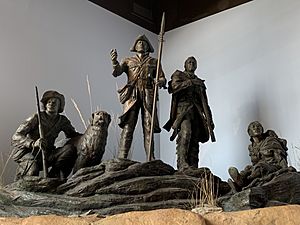
York played a very important role in the Lewis and Clark Expedition. He helped the team in many ways. Records from the trip show that York was treated almost equally to the white men on the expedition. He was allowed to use a rifle, which was unusual for enslaved people. When important decisions were made, York's opinion counted just as much as the other men's. He was also free to move around, unlike most enslaved people. York could have run away, but he chose to stay with the expedition.
Many people today believe York was essential to the journey. The expedition's journals often mention York's excellent hunting skills. He hunted buffalo, deer, and geese. His ability to use a rifle shows how much the other members trusted him. York also helped find new animal species, which was one of the expedition's goals. He did a lot of the hard work, like paddling boats, carrying supplies, and building shelters. He also helped find paths and navigate rivers.
York and Native Americans
York's most amazing contributions involved meeting Native American tribes. Their help was often very important for the expedition. The expedition journals say that York's dark skin fascinated the tribes. They were impressed by such a "strange creature." One historian called York "the main attraction in Lewis and Clark's traveling magic show." York was a sensation wherever they went.
Stories about York were passed down among Native American tribes for many years. Some of these stories lasted until the 20th century.
Reaching the Pacific and Voting
On November 18, 1805, York went with Clark to a tree at Cape Disappointment State Park, Washington. Clark carved his name and Lewis's name into the tree. York became the first African American to reach the Pacific Ocean. He walked 19 miles (30 km) from their camp with Clark.
Later that November, the leaders asked all members of the group, including York and Sacagawea, where they should camp for the winter. Some historians call this a "vote." Others say it was more like "polling" to get everyone's ideas. However, Clark wrote down what every person thought, which was very unusual for the time. The men on the expedition felt that they, not just the leaders, had made the decision.
Mentions in Clark's Journal
York's name appears 135 times in the journals kept by Lewis and Clark.
- On December 26, 1803, Clark wrote that York was working with other men.
- On June 5, 1804, Clark noted that York swam to a sandbar to gather greens for dinner. Many men on the expedition could not swim.
- On June 20, 1804, York almost lost an eye during a fight.
- Clark mentioned York was very tired after walking quickly up Spirit Mound Historic Prairie. Clark thought this was because York was too heavy.
- In September 1804, York killed an elk while on a hunting trip. It was unusual for enslaved people to be allowed to use firearms.
After the Expedition
After the expedition, all the white men received double pay and land. But York, being enslaved, received nothing.
Many people used to think Clark freed York right after they returned. However, York remained enslaved by Clark for at least five more years. He traveled with Clark to Washington D.C. in 1807. He also moved with Clark's family to St. Louis.
Historians believe that the freedom York experienced during the expedition made it very hard for him to return to slavery. York asked Clark for his freedom because of his great help during the journey.
York had gained some freedom during the expedition. He went on scouting trips and traded with Native American villages. Clark even named two places after him: York's Eight Islands and York's Dry Creek. This suggests Clark may have respected him. York's opinion was also recorded when the group decided where to stay for the winter.
William Clark's Letters
In 1988, 47 letters written by Clark to his brother were found. These letters showed new information about York. We learned that York had a wife before the expedition. She lived in the Louisville area and was enslaved by someone else. York wanted to return to Louisville to be with his wife. This caused a serious disagreement between him and Clark in 1808.
Clark moved to St. Louis in 1808. York and other enslaved people moved with him. By November 1808, Clark was angry because York refused to accept the move. York kept asking to be hired out in Louisville or sold to someone there. Clark wrote to his brother that York had "got Such a notion about freedom and his emence [immense] Services." Clark believed York would not be useful to him anymore.
Clark sent York to work for a strict nephew in Louisville. Clark wrote that he wanted York to have a "Severe Master" so he would "do Some Service." This is the last time York is mentioned in Clark's letters. A relative in Louisville wrote in 1811 that York's wife's owner was moving away. York was last mentioned in 1815, working as a wagon driver in Louisville.
The Black Man with the Crow Indians
Zenas Leonard was a fur trader who wrote about his travels in 1839. His book is considered very reliable by modern experts. Leonard wrote about meeting "a negro man" twice while traveling in what is now Wyoming. This man was living well among the Crows. He said he had first come to the area with Lewis and Clark. He had returned after visiting St. Louis.
The man Leonard met was described as an "old negro." He had become an important person, or chief, in the Crow village and had four wives. He knew their language well and was very respected by the Crow people. He seemed to live a happy and comfortable life.
Historians have discussed who this Black man might have been.
- Some thought it was Edward Rose, but he was not fully Black and died before Leonard's second meeting.
- Others suggested James Beckwourth, but he was too young to have been with Lewis and Clark.
- Many historians now believe the man Leonard met was York. The description of the man's size, dark skin, and age fits York. Also, York was very unhappy with Clark's refusal to free him. After his wife was moved away, York had less reason to stay in Louisville. It is possible York ran away from slavery and traveled to live with the Crow people.
York's Legacy
York clearly played a very important role in the Lewis and Clark Expedition. He did his work as a laborer, and his unique appearance fascinated Native American tribes. This helped the expedition travel through their lands and trade with them. The journals also suggest that many men on the expedition respected York.
How York is Remembered
Historian Darrell Millner has studied how York has been seen over 200 years. He describes two main ways York has been presented:
- The "Sambo" view: This older view showed York as a happy slave who needed a white owner to guide him. It often made his contributions seem small and showed him in a negative light.
- The "superhero" view: This more modern view sees York as an almost superhuman figure. It highlights his courage, bravery, and self-sacrifice. This view presents York as a role model who overcame the challenges of slavery and the frontier.
Creative Works About York
Many artists and writers have created works based on York's life:
- In 1972, Peter Michaelson wrote a poem/essay about York.
- In 1999, actor Hasan Davis began performing as York for the Kentucky Humanities Council. He shared York's story across the nation.
- An opera called York was performed in 2003.
- A one-man play called York premiered in 2005. It explores York's experiences, including his connection to African and Native American drumming.
- Kentucky poet Frank X Walker wrote two books of poetry about York: Buffalo Dance: The Journey of York (2004) and When Winter Come: The Ascension of York (2008). These poems tell York's story from his point of view, from slavery to freedom.
Honors for York
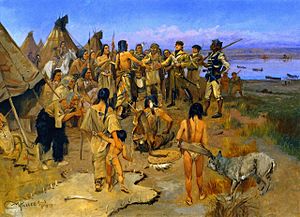
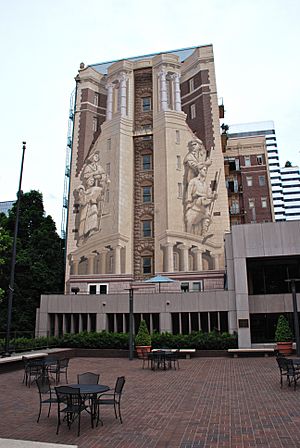
York has been honored in many ways:
- York appears in several paintings by Western artist Charles Marion Russell. In one painting from 1897, York is well-dressed. In another from 1905, he is working in plain clothes. A 1908 painting shows York meeting Native Americans who are curious about his dark skin.
- In 1988, a sculpture called The Naming of Mt. Jefferson was placed at the University of Portland. It shows William Clark, York, and a Native American, representing the three races that helped the expedition. In 2020, the statue of York was removed from this sculpture.
- In 1989, a statue group called "Explorers at the Portage" was put in Great Falls, Montana. It shows Lewis, Clark, York, and the expedition's dog, Seaman.
- Also in 1989, artist Richard Haas created a large mural for the former Sovereign Hotel in Portland. It shows people from the Lewis & Clark Expedition, including York.
- In 2000, Yorks Islands in the Missouri River were officially named for York. A small stream was also named after him.
- In 2001, President Bill Clinton gave York the honorary rank of sergeant in the United States Army.
- In 2001, York was added to the Hall of Great Westerners in Oklahoma City.
- In 2002, the City Council of Portland decided that "York Street" in their city would be understood to refer to this York.
- In 2003, a statue of York by sculptor Ed Hamilton was placed in Louisville, Kentucky.
- In 2010, a 6-foot bronze statue called York: Terra Incognita was put on the campus of Lewis and Clark College in Portland, Oregon. The artist focused on the statue's back, which is "scarred" with parts of William Clark's maps.
- In 2021, a 4-foot bust of York was secretly placed in Mount Tabor Park in Portland, Oregon. It was put on the base of a toppled statue of a pioneer. The bust was later damaged.
Videos About York
- 2005: York, the slave of William Clark.
- 2009: Searching for York.
- 2017: York: One Man's Story.
- 2018: York: American's Forgotten Explorer.
- 2020: A Conversation with Hasan Davis: York, Equity, Race and the Lewis and Clark Story.
- 2020: York: The African American Man Traveling with the Lewis & Clark Expedition.
- 2021: Lewis & Clark State Historic Site, Illinois Department of Natural Resources.
- York Before the Expedition.
- Building the Team VII: York On the Expedition.
- York After the Expedition.
See also
- Estevanico
- List of people from the Louisville metropolitan area
- List of enslaved people
- Shields Green
- Stephen Bishop (cave explorer)



